ESP FIAT DOBLO COMBI 2017 2.G Owner's Guide
[x] Cancel search | Manufacturer: FIAT, Model Year: 2017, Model line: DOBLO COMBI, Model: FIAT DOBLO COMBI 2017 2.GPages: 300, PDF Size: 24.91 MB
Page 198 of 300

WARNING
4)Used engine oil and oil filters contain
substances which are harmful to the
environment. Contact a Fiat Dealership to
have the oil and filters changed. They
are equipped to dispose of the used oil
and filters respecting nature and the law.
5)Power steering fluid consumption is
extremely low; if another top-up is required
after only a short period of time, have the
system checked for leaks at a Fiat
Dealership.
AIR CLEANER/
POLLEN FILTER
Have the air cleaner or the pollen filter
replaced by a Fiat Dealership.
DIESEL FILTER
DRAINING
CONDENSATION
(MultiJet versions)
36)
WARNING
36)The presence of water in the supply
circuit may cause severe damage to the
injection system and irregular engine
operation. If the
warning light comes
on, go to a Fiat Dealership as soon as
possible to have the system bled. If this
problem is indicated immediately after
refuelling, water may have entered the fuel
tank. In this case, immediately turn off
the engine and contact a Fiat Dealership.
194
SERVICING AND CARE
Page 200 of 300

145)When performing any operation on
the battery or near it, always protect your
eyes with special goggles.
WARNING
37)Incorrect assembly of electrical and
electronic devices may cause severe
damage to your vehicle. Contact a Fiat
Dealership if you want to install
accessories (alarms, radiophone, etc.):
they will suggest the most suitable devices
and advise you if a higher capacity battery
needs to be installed.
38)If the vehicle needs to be off the road
for a long period under conditions of
intense cold, remove the battery and take it
to a heated location, otherwise it may
freeze.
WARNING
6)Batteries contain substances which are
very dangerous for the environment. To
replace your battery, we recommend
contacting your Fiat Dealership to dispose
of your old battery in full respect of the
environment and in compliance with all
applicable laws and regulations.
RECHARGING THE
BATTERY
IMPORTANT The battery recharging
procedure is provided for information
purposes only. This operation should be
performed at a Fiat Dealership.
IMPORTANT Charging should be slow
at a low ampere rating for
approximately 24 hours. Charging for a
longer time may damage the battery.
IMPORTANT If a "quick-type" battery
charger is used with the battery fitted
on the car, before connecting it
disconnect both cables of the battery
itself. Do not use a "quick-type" battery
charger to provide the starting voltage.
To recharge, proceed as follows:
IN THE ABSENCE OF THE
START&STOP SYSTEM
disconnect the terminal from the
negative battery pole;
connect the charger cables to the
battery terminals, observing the poles;
turn on the charger;
when you have finished, turn the
charger off before disconnecting the
battery;
reconnect the terminal to the
negative battery pole.WITH START&STOP
SYSTEM
Versions with dummy pole fig. 220
disconnect the quick release
negative terminal A from the dummy
negative terminal B; this is because
a battery status monitoring sensor D is
fitted on the negative battery terminal
C and should never be disconnected
except for when the battery is actually
replaced;
connect the positive cable of the
charger to the positive pole of the
battery and the negative cable to the
dummy negative terminal B;
turn on the charger;
after the recharge, turn the charger
off before disconnecting it from the
battery;
220F0V0381
196
SERVICING AND CARE
Page 206 of 300

Exterior plastic parts should be cleaned
in the same way as the rest of the
vehicle. Where possible, do not park
the vehicle under trees; the resinous
substances released by many species
give the paint a dull appearance and
increase the possibility of corrosion.
IMPORTANT Bird droppings should be
washed off immediately and thoroughly
as the acid they contain is particularly
aggressive.
7)
Windows
To clean glasses, use specific cleaning
products. Use clean cloths to avoid
scratching the glass or damaging the
transparency.
IMPORTANT Wipe the inside surface of
the rear window gently with a cloth in
the direction of the filaments to avoid
damaging the heater coils.
Engine compartment
At the end of each winter, thoroughly
wash the engine compartment, taking
care to avoid spraying the water jet
directly onto the electronic control units
and the relay/fuse box on the left side
of the engine compartment (driving
direction). Have this operation
performed at a specialised workshop.IMPORTANT The washing should take
place with the engine cold and the
ignition key in the STOP position. After
the washing operation, make sure
that the various protections (e.g. rubber
caps and guards) have not been
removed or damaged.
Headlights
IMPORTANT Never use aromatic
substances (e.g. petrol) or ketones (e.g.
acetone) for cleaning the plastic lenses
of the front headlights.
WARNING
39)Some car washes with old-style blades
and/or in a poor state of repair can
damage the paintwork, facilitating the
formation of lines that give the paint
a dull/misty appearance, especially on dark
colours. If this happens, lightly polish the
paintwork with appropriate products.
WARNING
7)Detergents cause water pollution. The
vehicle should be washed in areas
equipped for collecting and purifying the
liquid used in the washing process.
INTERIORS
Regularly check that water is not
trapped under the mats (due to water
dripping off shoes, umbrellas, etc.),
as this could cause oxidation of the
sheet metal.
153) 154)
SEATS AND FABRIC
PARTS
Remove dust with a soft brush or a
vacuum cleaner. It is advisable to use a
moist brush on velvet upholstery.
Rub the seats with a sponge moistened
with a solution of water and mild soap.
PLASTIC PARTS
It is advisable to clean interior parts with
a moist cloth and a solution of water
and non-abrasive mild soap. Use
specific products for cleaning plastic,
without solvents and specifically
designed to prevent damage to the
appearance and colour of the treated
parts, to remove grease and tough
stains.
IMPORTANT Do not use alcohol,
petrols or their derivatives to clean the
instrument panel glass.
202
SERVICING AND CARE
Page 210 of 300
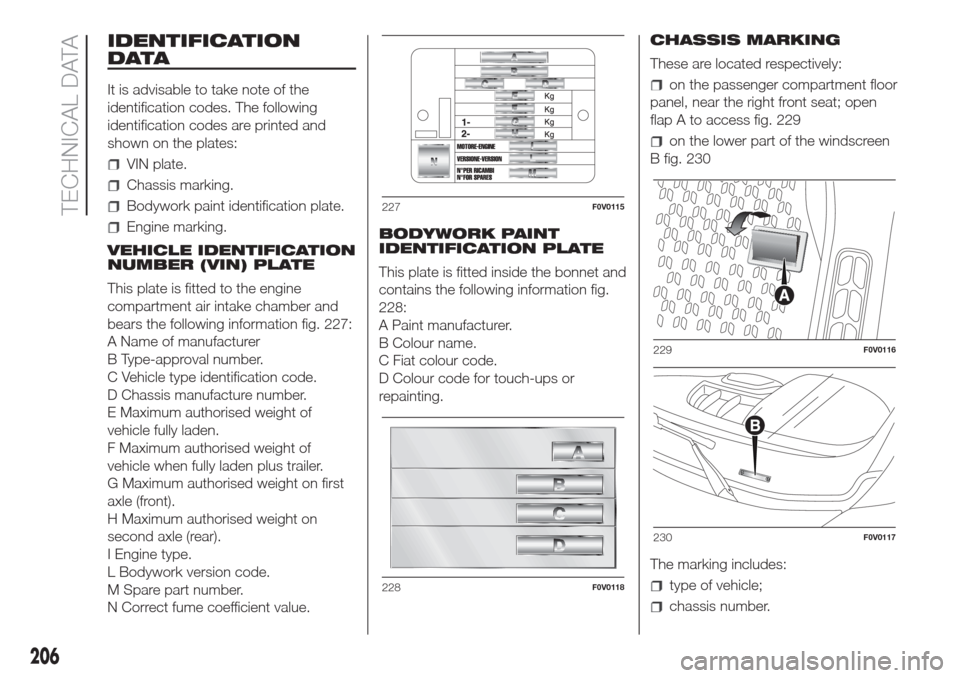
IDENTIFICATION
DATA
It is advisable to take note of the
identification codes. The following
identification codes are printed and
shown on the plates:
VIN plate.
Chassis marking.
Bodywork paint identification plate.
Engine marking.
VEHICLE IDENTIFICATION
NUMBER (VIN) PLATE
This plate is fitted to the engine
compartment air intake chamber and
bears the following information fig. 227:
A Name of manufacturer
B Type-approval number.
C Vehicle type identification code.
D Chassis manufacture number.
E Maximum authorised weight of
vehicle fully laden.
F Maximum authorised weight of
vehicle when fully laden plus trailer.
G Maximum authorised weight on first
axle (front).
H Maximum authorised weight on
second axle (rear).
I Engine type.
L Bodywork version code.
M Spare part number.
N Correct fume coefficient value.BODYWORK PAINT
IDENTIFICATION PLATE
This plate is fitted inside the bonnet and
contains the following information fig.
228:
A Paint manufacturer.
B Colour name.
C Fiat colour code.
D Colour code for touch-ups or
repainting.CHASSIS MARKING
These are located respectively:
on the passenger compartment floor
panel, near the right front seat; open
flap A to access fig. 229
on the lower part of the windscreen
B fig. 230
The marking includes:
type of vehicle;
chassis number.
227F0V0115
228F0V0118
229F0V0116
230F0V0117
206
TECHNICAL DATA
Page 214 of 300
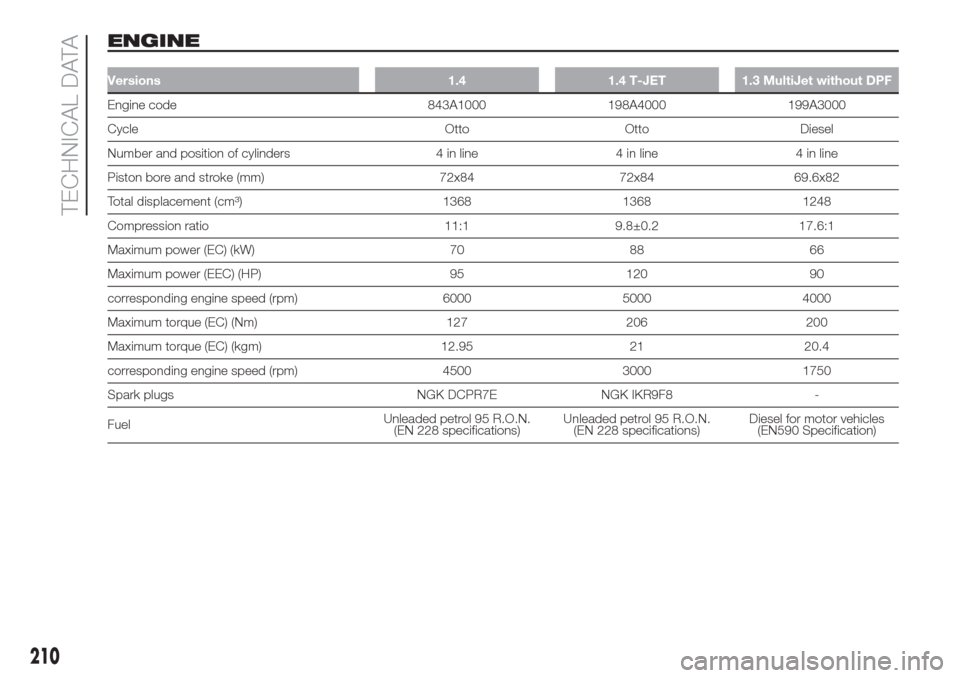
ENGINE
Versions 1.4 1.4 T-JET 1.3 MultiJet without DPF
Engine code 843A1000 198A4000 199A3000
Cycle Otto Otto Diesel
Number and position of cylinders 4 in line 4 in line 4 in line
Piston bore and stroke (mm) 72x84 72x84 69.6x82
Total displacement (cm³) 1368 1368 1248
Compression ratio 11:1 9.8±0.2 17.6:1
Maximum power (EC) (kW) 70 88 66
Maximum power (EEC) (HP) 95 120 90
corresponding engine speed (rpm) 6000 5000 4000
Maximum torque (EC) (Nm) 127 206 200
Maximum torque (EC) (kgm) 12.95 21 20.4
corresponding engine speed (rpm) 4500 3000 1750
Spark plugs NGK DCPR7E NGK IKR9F8 -
FuelUnleaded petrol 95 R.O.N.
(EN 228 specifications)Unleaded petrol 95 R.O.N.
(EN 228 specifications)Diesel for motor vehicles
(EN590 Specification)
210
TECHNICAL DATA
Page 215 of 300

Versions 1.3 MultiJet with DPF 1.3 Multijet Euro 61.6 Multijet Euro 4 / Euro 5
/ Euro 5+
Engine code 263A2000 / 263A6000 330A1000/225A2000198A3000 / 263A3000 /
263A4000 / 263A5000
Cycle Diesel Diesel Diesel
Number and position of cylinders 4 in line 4 in line 4 in line
Piston bore and stroke (mm) 69.6x82 69.6x82 79.5x80.5
Total displacement (cm³) 1248 1248 1598
Compression ratio 16.8:1 16.8:1 16.5:1
Maximum power (EC) (kW) 66/55 70/59 77/74/66
Maximum power (EEC) (HP) 90/75 95/80 105/100/90
corresponding engine speed (rpm) 4000 3750 4000
Maximum torque (EC) (Nm) 200 200
290/200
(*)
Maximum torque (EC) (kgm) 20.4 20.4
29.6/20.4(*)
corresponding engine speed (rpm) 1500 1500 1500
Spark plugs - - -
FuelDiesel for motor vehicles (EN
590 Specification)Diesel for motor vehicles (EN
590 Specification)Diesel for motor vehicles (EN
590 Specification)
(*) Engine code 263A5000
211
Page 216 of 300

Versions 1.6 Multijet Euro 6 2.0 Multijet
Engine code940C1000 / 263A8000 / 263A7000 /
263A9000263A1000
Cycle Diesel Diesel
Number and position of cylinders 4 in line 4 in line
Piston bore and stroke (mm) 79.5x80.5 83x90.5
Total displacement (cm³) 1598 1956
Compression ratio 16.5+-0.4 16.5:1
Maximum power (EC) (kW) 88/77/70/74 99
Maximum power (EEC) (HP) 120/105/95/100 135
corresponding engine speed (rpm) 3750/3750/2500/3750 3500
Maximum torque (EC) (Nm) 320/300/300/300 320
Maximum torque (EC) (kgm) 32.6/30.6/30.6/30.6 32.6
corresponding engine speed (rpm) 1750 1500
Spark plugs - -
FuelDiesel for motor vehicles (EN590
Specification)Diesel for motor vehicles (EN 590
Specification)
212
TECHNICAL DATA
Page 220 of 300
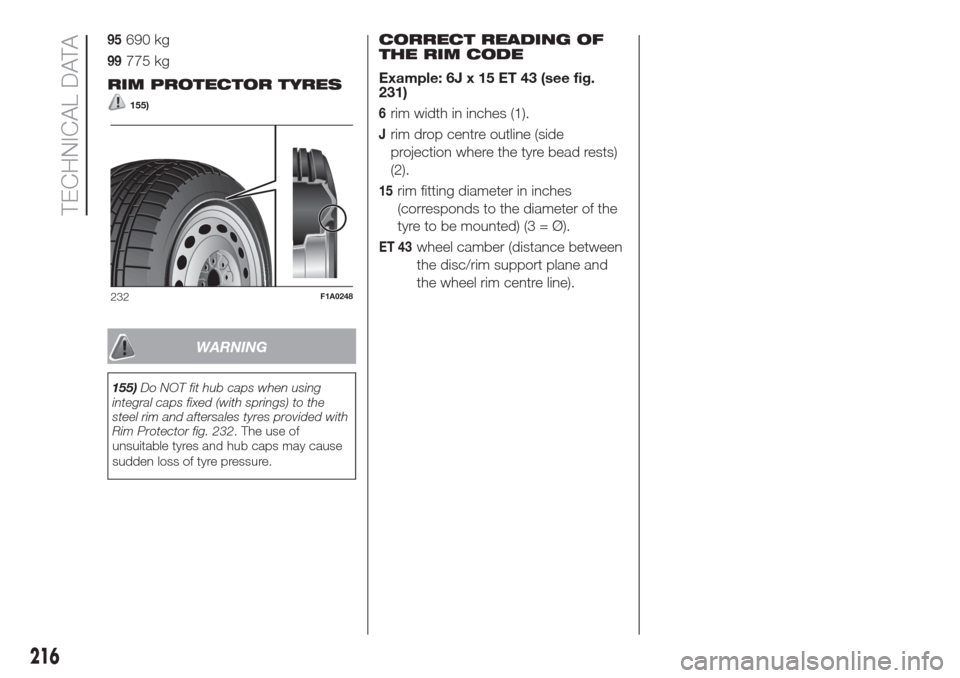
95690 kg
99775 kg
RIM PROTECTOR TYRES
155)
WARNING
155)Do NOT fit hub caps when using
integral caps fixed (with springs) to the
steel rim and aftersales tyres provided with
Rim Protector fig. 232. The use of
unsuitable tyres and hub caps may cause
sudden loss of tyre pressure.
CORRECT READING OF
THE RIM CODE
Example: 6J x 15 ET 43 (see fig.
231)
6rim width in inches (1).
Jrim drop centre outline (side
projection where the tyre bead rests)
(2).
15rim fitting diameter in inches
(corresponds to the diameter of the
tyre to be mounted) (3 = Ø).
ET 43wheel camber (distance between
the disc/rim support plane and
the wheel rim centre line).
232F1A0248
216
TECHNICAL DATA
Page 229 of 300
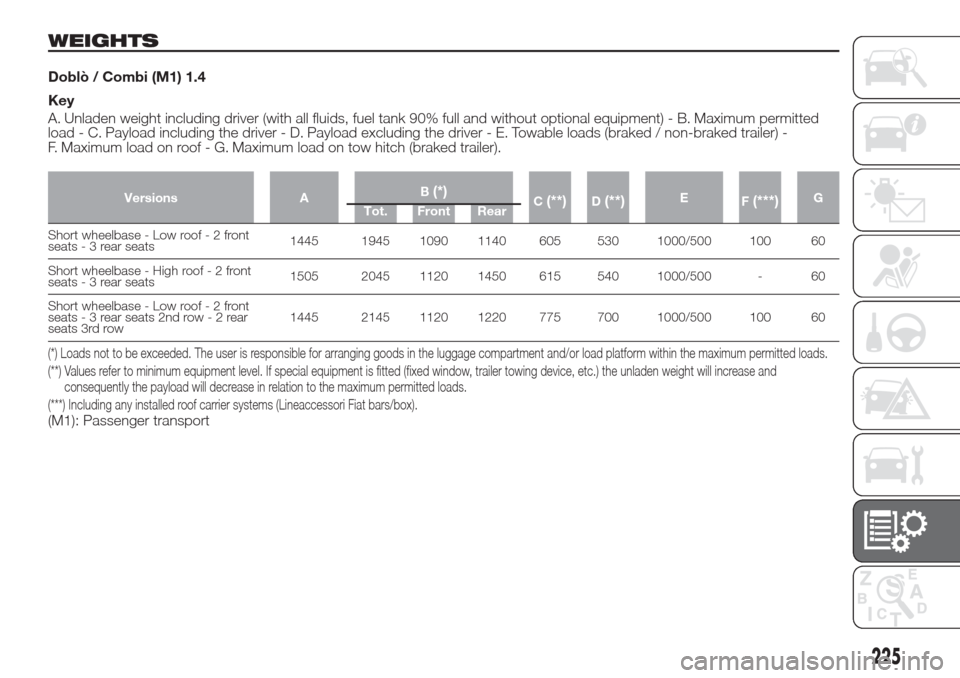
WEIGHTS
Doblò / Combi (M1) 1.4
Key
A. Unladen weight including driver (with all fluids, fuel tank 90% full and without optional equipment) - B. Maximum permitted
load - C. Payload including the driver - D. Payload excluding the driver - E. Towable loads (braked / non-braked trailer) -
F. Maximum load on roof - G. Maximum load on tow hitch (braked trailer).
Versions AB(*)C(**)D(**)E
F(***)G
Tot. Front Rear
Short wheelbase - Low roof-2front
seats-3rearseats1445 1945 1090 1140 605 530 1000/500 100 60
Short wheelbase - High roof-2front
seats-3rearseats1505 2045 1120 1450 615 540 1000/500 - 60
Short wheelbase - Low roof-2front
seats-3rearseats 2nd row-2rear
seats 3rd row1445 2145 1120 1220 775 700 1000/500 100 60
(*) Loads not to be exceeded. The user is responsible for arranging goods in the luggage compartment and/or load platform within the maximum permittedloads.
(**) Values refer to minimum equipment level. If special equipment is fitted (fixed window, trailer towing device, etc.) the unladen weight will increase and
consequently the payload will decrease in relation to the maximum permitted loads.
(***) Including any installed roof carrier systems (Lineaccessori Fiat bars/box).
(M1): Passenger transport
225
Page 230 of 300
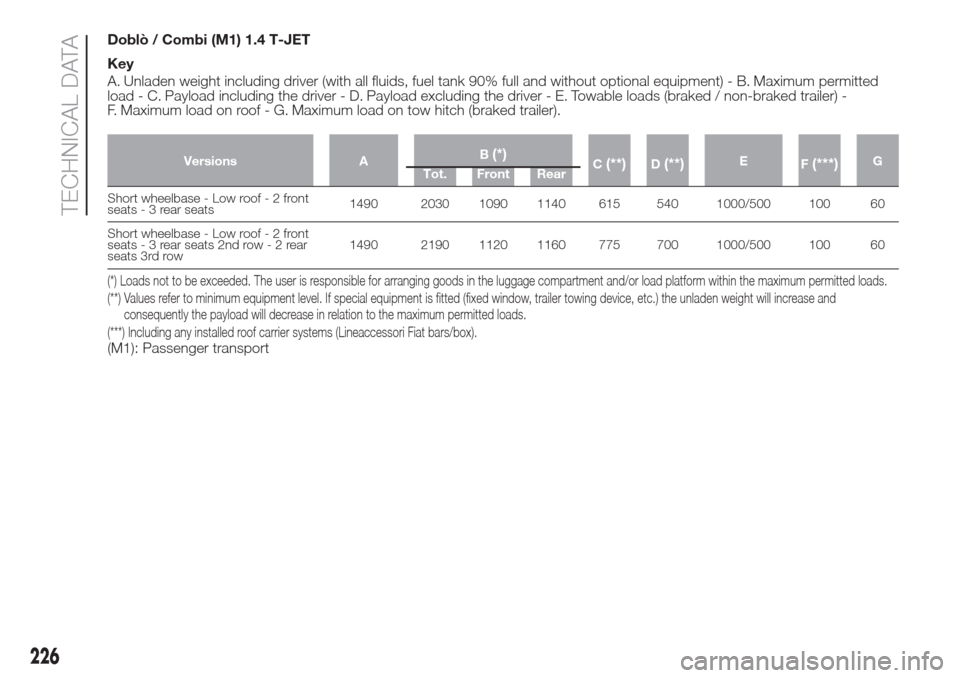
Doblò / Combi (M1) 1.4 T-JET
Key
A. Unladen weight including driver (with all fluids, fuel tank 90% full and without optional equipment) - B. Maximum permitted
load - C. Payload including the driver - D. Payload excluding the driver - E. Towable loads (braked / non-braked trailer) -
F. Maximum load on roof - G. Maximum load on tow hitch (braked trailer).
Versions AB(*)C(**)D(**)E
F(***)G
Tot. Front Rear
Short wheelbase - Low roof-2front
seats-3rearseats1490 2030 1090 1140 615 540 1000/500 100 60
Short wheelbase - Low roof-2front
seats-3rearseats 2nd row-2rear
seats 3rd row1490 2190 1120 1160 775 700 1000/500 100 60
(*) Loads not to be exceeded. The user is responsible for arranging goods in the luggage compartment and/or load platform within the maximum permittedloads.
(**) Values refer to minimum equipment level. If special equipment is fitted (fixed window, trailer towing device, etc.) the unladen weight will increase and
consequently the payload will decrease in relation to the maximum permitted loads.
(***) Including any installed roof carrier systems (Lineaccessori Fiat bars/box).
(M1): Passenger transport
226
TECHNICAL DATA